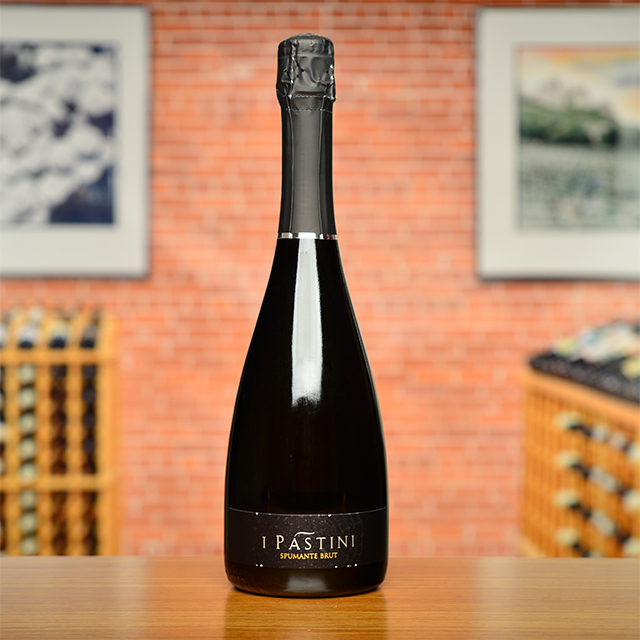Notify me
2021 Locorotondo Bianco “Antico”
I Pástini
The Locorotondo appellation, midway between Bari and Brindisi near Puglia’s Adriatic coastline, is the antithesis to the brawny, opaque, alcoholic reds for which the heel of the boot is best known. Instead, the area produces delicate, crisp white wines from rare local grapes. In this case, Verdeca, Bianco d’Alessano, and a splash of the aromatic Minutolo combine to create a breezy bianco scented of lemon, straw, and fresh-picked herbs. It shines at aperitivo hour, paired with some green olives and a pastel sunset over the horizon.
—Anthony Lynch
| Wine Type: | white |
| Vintage: | 2021 |
| Bottle Size: | 750mL |
| Blend: | 60% Verdeca, 35% Bianco d’Alessano, 5% Minutolo |
| Country: | Italy |
| Region: | Puglia |
| Producer: | I Pástini |
| Winemaker: | Gianni Carparelli |
| Vineyard: | Planted in 2001 |
| Soil: | Red clay, limestone |
| Aging: | Aged in stainless steel tanks for 5 to 6 months |
| Farming: | Organic (certified) |
| Alcohol: | 12% |
More from this Producer or Region

2023 Valle d’Itria Spumante Brut
Italy | Puglia
Verdeca, a specialty around the town of Locorotondo, stars in this bottling that drinks like a southern Prosecco: light, crisp, and citrusy, with a playful bead.

2023 Valle d’Itria Minutolo “Rampone”
Italy | Puglia
Crafted from the local variety Minutolo, Pástini’s Rampone preserves lip-smacking acidity and low alcohol despite the baking-hot Puglian summers
 /
/
About The Producer
I Pástini
I Pástini is a small, family-run winery in the Valle d’Itria in eastern central Puglia. Founded by Gianni Carparelli and his father Donato, they grow three local white grapes, Verdeca, Bianco d’Alessano, and Minutolo, and the local red grape, Susumaniello, on land their ancestors worked: a beautiful limestone plateau overlooking the Adriatic Sea that is co-planted to ancient, (multi-millennia old!), olive groves.
After vinifying their wines in a neighbor’s cantina for a number of years they built their own winery and cellars, which came online in 2012. They are currently nearing the end of their organic conversion in the vineyards and will be certified organic starting with the 2019 vintage.
About The Region
Puglia

Puglia is Italy’s second most prolific wine-producing region (after the Veneto) and for decades was known as a source of bulk wine. But today, the heel of the boot is more than ever focused on quality, as ambitious growers seek to take advantage of the area's abundant natural riches to produce wines of character and identity. The hot, dry climate and marine influence from the long Adriatic coastline predispose Puglia to growing high-quality fruit, while a wealth of fascinating indigenous grape varieties thrive in these conditions. Changing fashion and a growing respect for the region's mostly calcareous terroirs have breathed fresh air into the Puglian wine scene, and with more than thirty distinct appellations, it is home to a tremendous variety of styles.
While the region is best known for inky, concentrated reds from grapes such as Primitivo and Negroamaro, the first KLWM Puglian imports are in fact white wines—aromatic charmers made from native varieties including Verdeca and the rare Minutolo. They hail from central Puglia’s Valle d’Itria, a plateau that shares a relatively flat topography and limestone soils with the Salento peninsula in the south. The north, in contrast, is hillier and features grapes more common to southern and central Italy including Montepulciano, Sangiovese, and Trebbiano.
Puglian wines are the product of intense southern sunshine and an ancient history of viticulture. With other local specialties including olive oil and burrata, the region has enormous potential for delicious combinations.
More from Puglia or Italy
2024 Vino Bianco
Elvio Tintero Italy | Piedmont
2022 Friuli Colli Orientali Pinot Grigio “Ronco Pitotti”
Vignai da Duline Italy | Friuli
2023 Verdicchio dei Castelli di Jesi
Colleleva Italy | Le Marche
2023 Toscana Rosato
Sesti Italy | Tuscany
2020 Friuli Colli Orientali Refosco Peduncolo Rosso “Morus Nigra”
Vignai da Duline Italy | Friuli
2023 Valle d’Itria Minutolo “Rampone”
I Pástini Italy | Puglia
2020 Barolo “Le Coste di Monforte”
Piero Benevelli Italy | Piedmont
2021 Isola Dei Nuraghi “Familia”
Deperu Holler Italy | Sardinia
2023 Olio Extra Vergine di Oliva
Riofavara Italy | Sicily
2022 Chardonnay “Ronco Pitotti”
Vignai da Duline Italy | Friuli
2020 Venezia Giulia Sauvignon
Edi Kante Italy | Friuli
2023 Valle d’Itria Spumante Brut
I Pástini Italy | Puglia
2024 Vino Bianco
Elvio Tintero Italy | Piedmont
2022 Friuli Colli Orientali Pinot Grigio “Ronco Pitotti”
Vignai da Duline Italy | Friuli
2023 Verdicchio dei Castelli di Jesi
Colleleva Italy | Le Marche
2023 Toscana Rosato
Sesti Italy | Tuscany
2020 Friuli Colli Orientali Refosco Peduncolo Rosso “Morus Nigra”
Vignai da Duline Italy | Friuli
2023 Valle d’Itria Minutolo “Rampone”
I Pástini Italy | Puglia
2020 Barolo “Le Coste di Monforte”
Piero Benevelli Italy | Piedmont
2021 Isola Dei Nuraghi “Familia”
Deperu Holler Italy | Sardinia
2023 Olio Extra Vergine di Oliva
Riofavara Italy | Sicily
2022 Chardonnay “Ronco Pitotti”
Vignai da Duline Italy | Friuli
2020 Venezia Giulia Sauvignon
Edi Kante Italy | Friuli
2023 Valle d’Itria Spumante Brut
I Pástini Italy | Puglia
Kermit once said...

Kermit once said...
If you're looking for value, look where no one else is looking.
Inspiring Thirst, page 211














